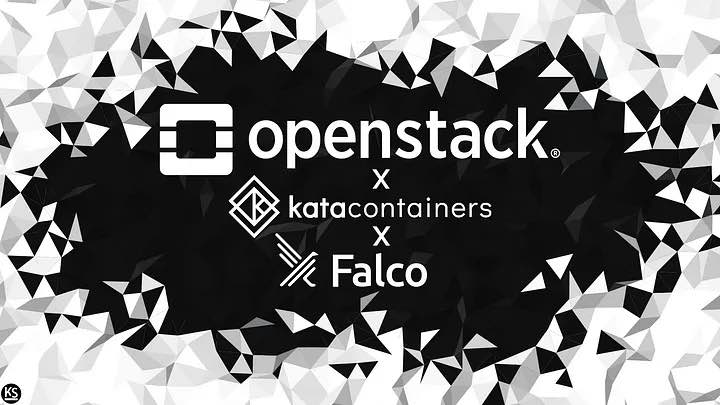In today’s fast-paced digital landscape, security has become a paramount concern for organizations handling sensitive data. OpenStack, an open-source cloud computing platform, provides a robust infrastructure for deploying and managing cloud resources. When combined with Kata Containers and Falco, OpenStack becomes an incredibly secure setup. In this blog, we will explore the reasons why this combination is considered one of the most secure setups available, along with five practical use cases that demonstrate its effectiveness.
Use Case 1: Isolation and Stronger Security Boundaries
Kata Containers, an open source project, leverages lightweight virtual machines (VMs) to achieve container isolation and security. By utilizing hardware virtualization, Kata Containers ensures that each container runs in its own lightweight VM, providing stronger security boundaries between containers. With OpenStack, you can seamlessly deploy Kata Containers and benefit from enhanced isolation, reducing the risk of container escape vulnerabilities.
Example: In a multi-tenant environment, an organization can deploy a highly secure web application using OpenStack and Kata Containers. Each tenant’s application runs within a dedicated lightweight VM, ensuring isolation and preventing any unauthorized access to sensitive data or potential cross-tenant attacks.
Use Case 2: Runtime Threat Detection and Prevention
Falco, an open-source cloud-native runtime security tool, focuses on detecting and preventing abnormal activities within containerized environments. It leverages Kubernetes auditing and system call monitoring to detect malicious behaviors and policy violations in real-time. By integrating Falco with OpenStack, you can benefit from its advanced threat detection capabilities within your OpenStack-based cloud infrastructure.
Example: An e-commerce platform running on OpenStack can deploy Falco to monitor and detect potential security breaches in real time. Falco can detect suspicious activities such as privilege escalations, abnormal network connections, or unauthorized file access, triggering immediate alerts and preventing potential data breaches.
Use Case 3: Compliance and Auditing
In highly regulated industries such as finance or healthcare, compliance with security standards is critical. OpenStack, combined with Kata Containers and Falco, offers a strong foundation for meeting compliance requirements and facilitating auditing processes. The enhanced isolation and real-time threat detection provided by this setup help organizations ensure that security policies and regulations are followed.
Example: A healthcare organization leveraging OpenStack can deploy Kata Containers and Falco to host and secure patient data. The setup ensures that each patient’s data is isolated within dedicated lightweight VMs, and Falco actively monitors for any unauthorized access attempts, ensuring compliance with privacy regulations like HIPAA.
Use Case 4: Secure DevOps and CI/CD Pipelines
Integrating security into the DevOps and CI/CD processes is essential for delivering secure and reliable applications. OpenStack, combined with Kata Containers and Falco, enables organizations to build secure and automated deployment pipelines. Developers can create secure containerized applications, deploy them on OpenStack using Kata Containers, and continuously monitor their runtime environment using Falco.
Example: A software development team adopting a DevSecOps approach can leverage OpenStack with Kata Containers and Falco to build a secure CI/CD pipeline. Each stage of the pipeline, from code build to deployment, can be containerized within Kata Containers, ensuring isolation and security. Falco monitors the runtime environment, providing continuous security feedback during the pipeline execution.
Use Case 5: Disaster Recovery and Resilience
OpenStack’s inherent ability to distribute workloads across multiple nodes, combined with Kata Containers and Falco, enhances disaster recovery capabilities and system resilience. By deploying applications in highly available configurations, organizations can ensure that their services remain operational even during adverse situations. Falco’s real-time threat detection helps identify and mitigate security risks promptly.
Example: A financial institution can utilize OpenStack with Kata Containers and Falcoto to establish a highly resilient and secure disaster recovery setup. By deploying critical applications across multiple nodes using Kata Containers, the institution can ensure continuous availability. Falco monitors the runtime environment for any security threats, allowing immediate response and mitigation in the event of an incident.
Conclusion:
OpenStack, when combined with Kata Containers and Falco, provides a highly secure cloud infrastructure with enhanced isolation, real-time threat detection, and compliance capabilities. The five use cases discussed above illustrate the practical benefits of this setup, ranging from multi-tenant security and runtime threat prevention to compliance, secure DevOps, and disaster recovery. By adopting this powerful combination, organizations can build a robust and secure cloud infrastructure that meets their stringent security requirements.
Note: When implementing security measures, it is crucial to regularly update and patch all components, including OpenStack, Kata Containers, and Falco, to ensure the latest security features and fixes are in place.

)







